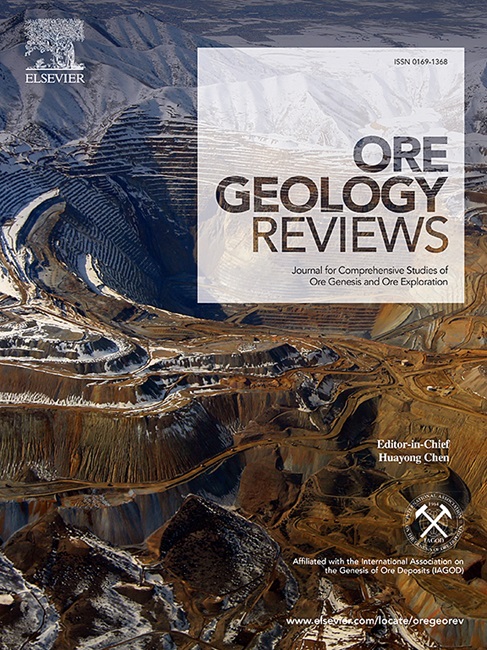Genesis of Cu deposits hosted by volcanic rocks in Yunxian-Jinggu Arc, Western Yunnan: Constraints from fluid inclusions and C-O-S isotopes
IF 3.2
2区 地球科学
Q1 GEOLOGY
引用次数: 0
Abstract
A series of vein-type Cu deposits have been preserved in the Triassic volcanic rocks of the Yunxian-Jinggu area. The Guanfang, Bazijie, and Minleyichang deposits are typical examples of regional Cu mineralization. The deposits are preserved in the intermediate-basic volcanic rocks, and the ore bodies are controlled by NNE-trending structures with similar alteration features and mineral assemblages. The fluid inclusions are recognized in quartz and calcite at the three deposits, dominated by aqueous inclusions (L) and liquid phase-rich vapor–liquid two-phase inclusions (L-V) with similar temperature (270-140℃) and salinity (14.0–20.2 wt% NaCl eq.). The three deposits have a medium–low temperature, moderate salinity, and higher oxidation rate than the volcanic host rocks, confirmed by the fluid inclusion, alteration, and mineral assemblage. The O isotope values for early quartz associated with sulfides in the three deposits are comparable (δ18OSMOW = 15.23 to 20.01 ‰). Late quartz in the Guanfang and Bazijie deposits shows a deficit in O isotope values compared to early quartz (δ18OSMOW = 9.89 to 13.98 ‰), indicating the incorporation of meteoric water or basin fluid during the late stage of mineralization. The early calcite in the Guanfang and Bazijie deposits have similar C-O isotopic signatures (δ13CV-PDB = −10.51 to −4.75 ‰, δ18OV-SMOW = 11.29 ‰ to 12.63 ‰), and δ18Ofluid (3.84 to 5.18 ‰) calculated from calcite is approximately the same as the δ18Ofluid (2.08 to 3.95 ‰) calculated from early quartz. The early calcite and early quartz in the Guanfang and Bazijie deposits may be connected to the same fluid source based on the similar δ18Ofluid signatures and salinities. The calcite C-O isotopic compositions of the Minleyichang deposit are 13CV-PDB = −23.03 to −17.74 ‰ and δ18OV-SMOW = 19.72 to 28.32 ‰, which exhibit the characteristics of biogenic carbon and indicate that the material originated from sedimentary layers in the Simao Basin. The sulfide δ34SV-CDT ranges from −17.2 to 3.2 ‰ in the three deposits, which is related to the addition of reduced S from the sedimentary strata in the Simao Basin. The fluid characteristics of medium to low temperature, moderate salinity, and the S-C isotope signatures indicate that the ore-forming fluids are the basin brine from the Simao Basin. The Cu mineralization in the Yunxian-Jinggu area is closely related to the thrust-fold structure system formed during the Late Cretaceous to the Cenozoic period. The ore-forming fluids may have come from the brine in the central part of the Simao Basin, which migrated through the thrust fault and assimilated the materials in the regional volcanic rocks and sedimentary rocks, forming Cu deposits in the Triassic volcanic rocks of Yunxian-Jinggu area.

滇西云县—景谷弧火山岩型铜矿床成因:流体包裹体和C-O-S同位素约束
云县—景谷地区三叠系火山岩中发现了一系列脉状铜矿床。官房、坝子街、民雷厂矿床是区域铜成矿的典型代表。矿床保存在中基性火山岩中,矿体受北北东向构造控制,蚀变特征和矿物组合相似。3个矿床的石英和方解石中均存在流体包裹体,以水包裹体(L)和富液相气液两相包裹体(L- v)为主,温度(270 ~ 140℃)和盐度(14.0 ~ 20.2 wt% NaCl eq.)相近。流体包裹体、蚀变和矿物组合均证实了3个矿床具有中低温、中等盐度、比火山岩寄主氧化速率高的特征。3个矿床中与硫化物有关的早期石英的O同位素值具有可比性(δ18OSMOW = 15.23 ~ 20.01‰)。官房和坝子街矿床的晚期石英与早期石英相比,O同位素值呈亏缺(δ18OSMOW = 9.89 ~ 13.98‰),表明成矿后期有大气水或盆地流体的掺入。官房和坝子街矿床的早期方解石具有相似的C-O同位素特征(δ13CV-PDB = - 10.51 ~ - 4.75‰,δ18OV-SMOW = 11.29‰~ 12.63‰),由方解石计算的δ 18o流体(3.84 ~ 5.18‰)与由早期石英计算的δ 18o流体(2.08 ~ 3.95‰)基本相同。官房和坝子街矿床的早期方解石和早期石英具有相似的δ18流体特征和盐度特征,可能与同一流体源有关。民雷厂矿床方解石C-O同位素组成为13CV-PDB = - 23.03 ~ - 17.74‰,δ 18ovs - smow = 19.72 ~ 28.32‰,具有生物成因碳的特征,表明物质来源于思茅盆地的沉积层。3个矿床硫化物δ34SV-CDT值在−17.2 ~ 3.2‰之间,与思茅盆地沉积地层中还原态硫的加入有关。中低温、中盐度流体特征及S-C同位素特征表明成矿流体为来自思茅盆地的盆地卤水。云县-景谷地区的铜成矿作用与晚白垩世至新生代形成的逆冲褶皱构造体系密切相关。成矿流体可能来自思茅盆地中部的卤水,通过逆冲断层运移,吸收了区域火山岩和沉积岩中的物质,形成了云县—景谷地区三叠系火山岩中的铜矿床。
本文章由计算机程序翻译,如有差异,请以英文原文为准。
求助全文
约1分钟内获得全文
求助全文
来源期刊

Ore Geology Reviews
地学-地质学
CiteScore
6.50
自引率
27.30%
发文量
546
审稿时长
22.9 weeks
期刊介绍:
Ore Geology Reviews aims to familiarize all earth scientists with recent advances in a number of interconnected disciplines related to the study of, and search for, ore deposits. The reviews range from brief to longer contributions, but the journal preferentially publishes manuscripts that fill the niche between the commonly shorter journal articles and the comprehensive book coverages, and thus has a special appeal to many authors and readers.
 求助内容:
求助内容: 应助结果提醒方式:
应助结果提醒方式:


